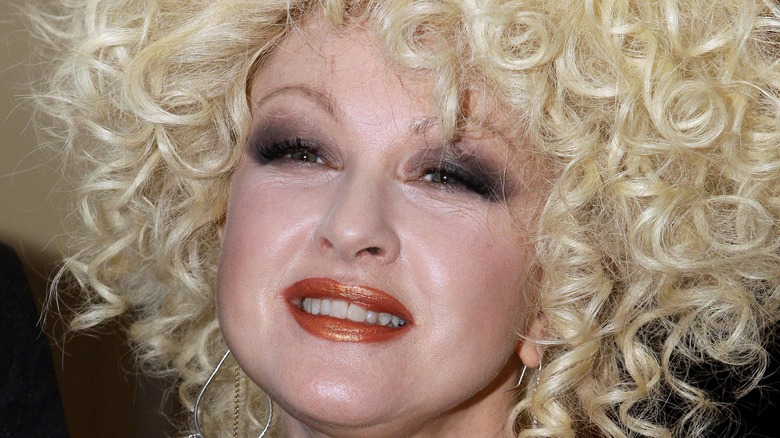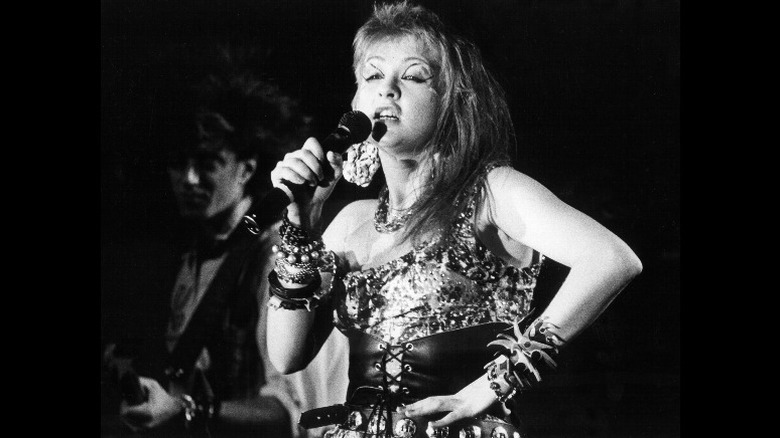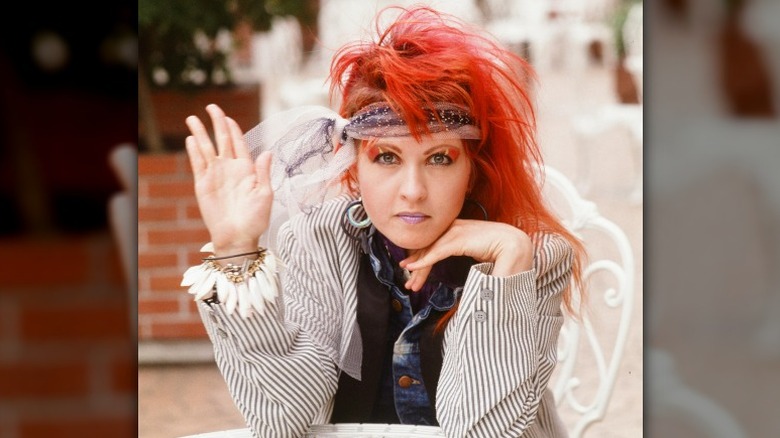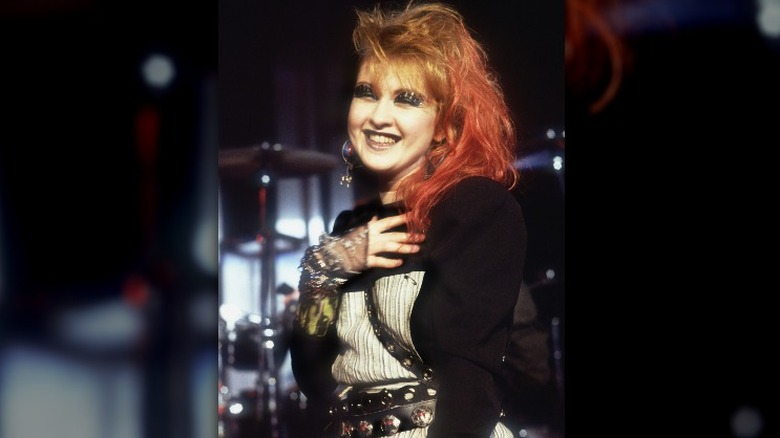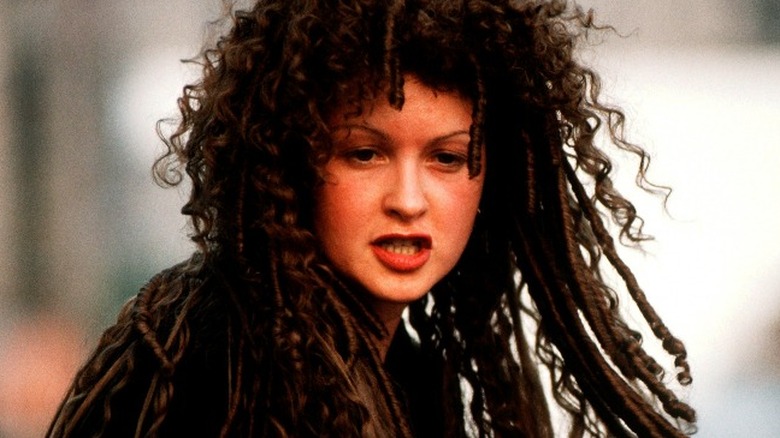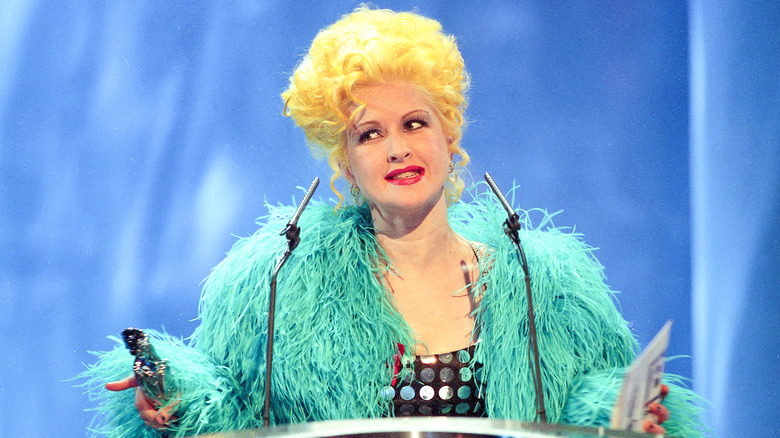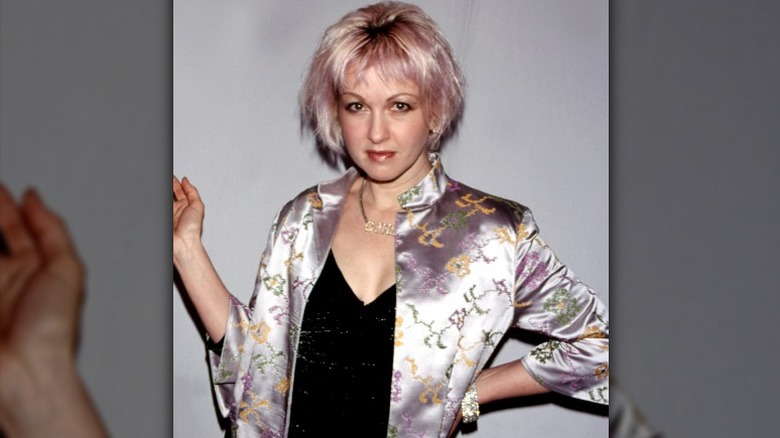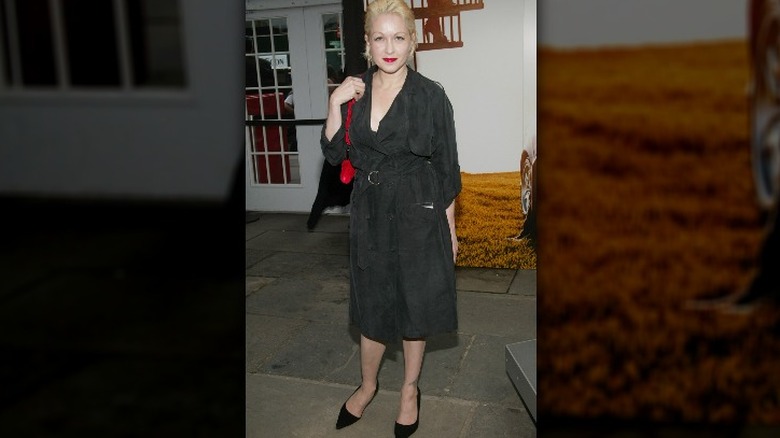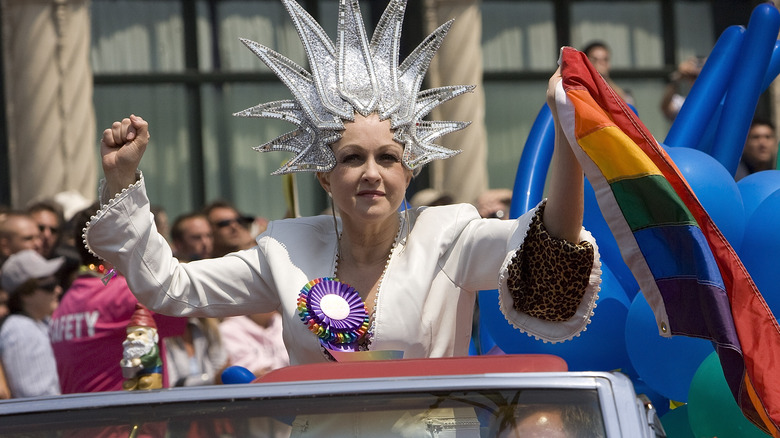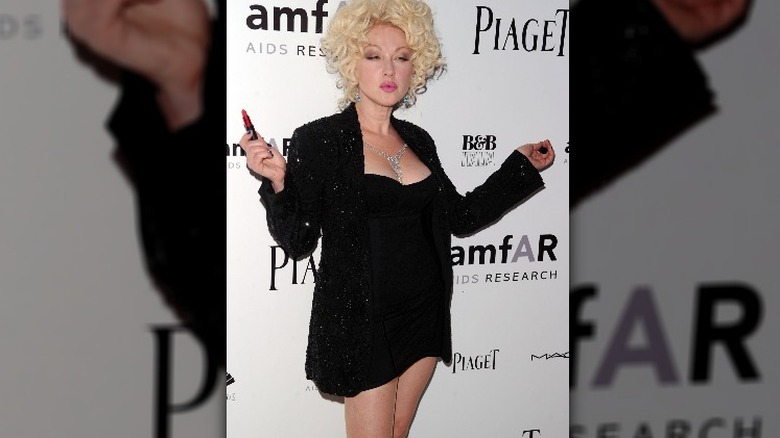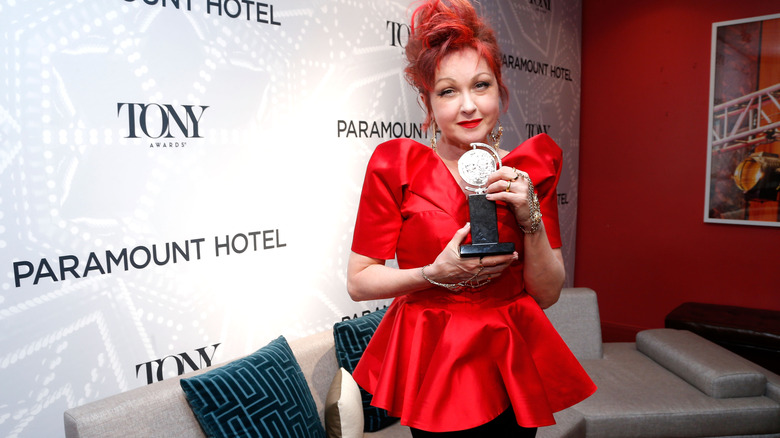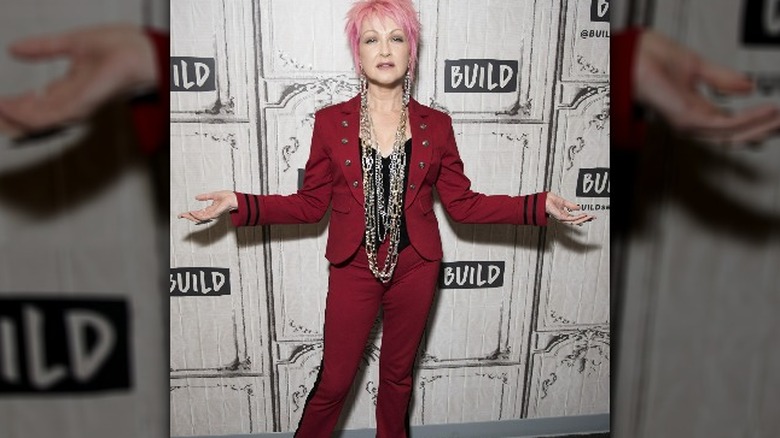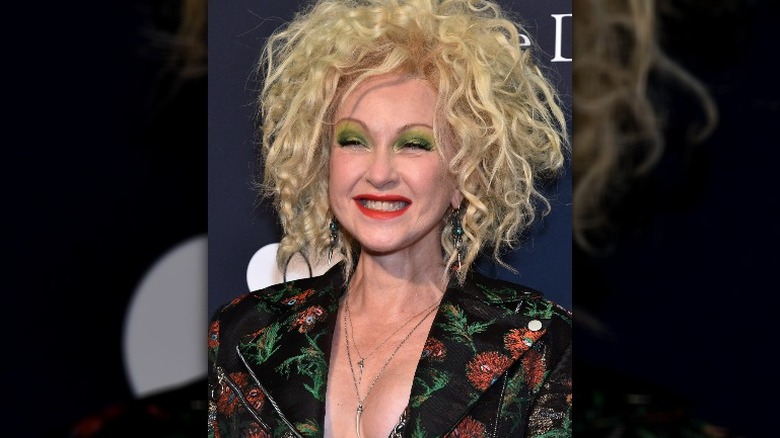The Transformation Of Cyndi Lauper From 17 To 68 Years Old
This article contains references to suicide and sexual assault.
Though she's paraded a multicolor metamorphosis throughout her career via a prism of hair hues and fashion statements, the transformation of Cyndi Lauper from 17 to 63 years old is a story of ongoing defiance, and pride in the face of adversity. Growing up, the iconoclastic superstar was a self-proclaimed outsider, her adventurous sense of style attracting the wrath of bullies. "When I was a kid, I dressed differently," she told The Times, "so people threw rocks at me."
As recounted in her autobiography, "Cyndi Lauper: A Memoir," the artist's teenage years were similarly fraught, with Lauper leaving home at 17 to escape her abusive stepfather who had threatened sexual assault against her and her sister (via HuffPost). But as is the case with much of Lauper's life story, she found salvation in art. The young star-in-the-making headed off into the world with, as she wrote in her memoir, "a paper bag with a toothbrush, a change of underwear, an apple, and a copy of Yoko Ono's book Grapefruit," and embarked on a life of self-exploration.
After a period of homelessness, she told Interview she found herself studying art at Johnson State College in Vermont, setting her on a path of creative fulfillment that would lead to her becoming a fully fledged star. All the while, Lauper's ever-changing looks would act like kaleidoscopic stamps in a passport of the heart — expressing where she'd been, what she was doing, and how she felt about it all. Here's exactly what they looked and sounded like.
If you or anyone you know has been a victim of sexual assault, help is available. Visit the Rape, Abuse & Incest National Network website or contact RAINN's National Helpline at 1-800-656-HOPE (4673).
First bands and first records
Some artists use paint, others photography. Cyndi Lauper used her voice and fashion sense to communicate her art. At the start of the '70s, the young runaway lent her vocals to two cover bands. And what vocals they are: As The Guardian once wrote, "Blessed with perfect pitch and a range of four octaves, her voice is a thing of wonder." As the singer recounted to Westword, she mostly performed classic rock songs in the two outfits, whose sets of Rod Stewart tunes inspired "part of" her vocal style on what would later become her first solo album.
Rocking her own street style — makeup inspired by punk icon Soo Catwoman and corsets as outerwear long before Madonna popularized it — it was clear Lauper's creative fortitude was long for more than simply serving up other people's work. By the time she was leading her first proper band, a rockabilly-inspired outfit called Blue Angel, it was clear her star power was too potent to be part of an ensemble.
As the band's manager Steve Massarky recalled to Rolling Stone, the reaction to the group's industry showcase was universal: "The singer's wonderful, get rid of the band." Per the outlet, after one critically acclaimed but commercially defeated album, Blue Angel were no more and Lauper was ready to become a star. Until that could happen though, the star subsequently worked in retail and "sang oldies at a Japanese piano bar" until it was her time to shine.
Cyndi Lauper's so unusual
When that time finally arrived, as recounted in Rolling Stone, Cyndi Lauper was discovered by David Wolff — a man who was to become her manager and boyfriend — and she was signed to Portrait Records. Her first album "She's So Unusual" made her an instant star, and the quirky 30-year-old with Kool-Aid Cherry hair helped to define the sound and style of the '80s. As she told Interview, the album was built around a "very strong, solid statement": "Be creative and be yourself." Her bright hair color was an extension of that statement, with the star telling the magazine, "I dyed my hair red because what was in my brains at that time was red" — anger, as well as passion.
It's something that can be clearly heard within the feminist statements of songs like "She Bop" — a female masturbation anthem which paved the way for tunes like Beyoncé's "Feeling Myself" — as well as the spirited, "Girls Just Want To Have Fun," the lyrics of which Lauper had to rewrite. "I tore it apart," she told Rolling Stone, "It was originally about how fortunate [the songwriter] was 'cause he was a guy around these girls that wanted to have 'fun' — with him — down there."
Instead, she made it a song that she, and women everywhere, could identify with. Who didn't wanna be the one to walk in the sun? And Lauper was all too happy to supply the soundtrack for the journey.
A superstar on the rise
In the mid-'80s, Cyndi Lauper had become an overnight sensation. But her sudden fame and success didn't settle easily with the star whose original, outsider style had suddenly become co-opted by the mainstream. "People used to throw rocks at me for my clothes" she told Rolling Stone, "Now they wanna know where I buy them." Having won Best New Artist at the 27th Annual Grammy Awards, Lauper was a certified sensation and everyone wanted a piece of her — but she may have been reluctant to so eagerly share herself.
The singer notoriously contributed to the saccharine charity track "We Are the World," but was called out by producer Quincy Jones as being difficult to work during recording in an interview with Vulture. Lauper denied such behavior during an appearance on "Watch What Happens Live," where she said she "was honored" to sing on the song. However, she did confess to her jewelry being "a pain in the a**" by rattling in front of the microphone during takes, as Jones had stated.
Perhaps, as Lauper's hit song suggested, the singer just wanted to have fun. And she enjoyed it via the world of professional wrestling where she not only found a bombastic home big enough for her cartoonish personality, but also helped to establish the mainstream success of the WWE due to her guest appearances, as stated by The Bleacher Report. The superstar knew what worlds she belonged in, and she'd continue to thrive by sticking to them.
Showing off her true colors
As Cyndi Lauper continued to climb the stratosphere of her career, her hair appropriately changed hue too. The ferocious red of her debut album clung to the ends of her shaggy hair, and a ferocious glow of gold now tousled out. It was as though her formative passions had set her aflame, and the star — now in her mid-30s — was carrying herself as a delicate torch for others to find route with. Second album "True Colors," may have further provided the map.
With lyrics that encouraged outsider pride in a world that seeks to diminish otherness, the album's title track became a bold LGBTQ anthem during the tragedies of the AIDS crisis. Speaking to Rolling Stone, the singer suggested that she "kept listening" to the demo of the track after losing her friend, Gregory Natal, to AIDS. Though she wrote album track "Boy Blue" specifically for her late pal, she knew "True Colors" was a "special song" that could connect with people in a unique way. "It's about being intimate and making someone feel like you're whispering in their ear," she told the magazine.
Music aside, the mid-'80s also saw Lauper attempting her first movie role as a psychic beauty therapist in "Vibes." Though she told the Los Angeles Times that she was determined not to depict "what Hollywood thinks a woman is," Roger Ebert countered that Lauper "essentially stands around being herself" instead. Hey, is that such a bad thing?
Hitting high and low notes
By the end of the '80s, Cyndi Lauper's fire had sadly burned out. Speaking to the Independent, the singer suggested she was artistically restrained by her record company who insisted she collaborate with others — for her songs, her looks, her sound — as they were "never happy" with her own ideas. Her third album "A Night to Remember" made her so miserable she called it "A Night to Forget" to the newspaper, and the singer's iconic rainbow-dipped hair was replaced with somber wigs of brown or pitch black.
It was a "dark time" for the star, as Lauper recalled in her memoir (via The Mirror). On top of feeling like she "disappointed the record company" by not living up to expectations, she had also split from her manager and partner David Wolff. "I thought the sadness would never go away," she wrote, stating that she'd sit in the studio "and drink vodka" while she was grieving, and even contemplated suicide. She was haunted by potential news reports, however, "I never wanted a headline to read, 'Girl who wanted to have fun just didn't.'"
Thankfully, the early '90s pulled Lauper back from the brink, and she met actor David Thornton on the set of the drama, "Off and Running" — the filming of which she described as "the chance of a vacation from myself" to the Independent. The two fell in love, and were married by the end of 1991.
If you or someone you know is struggling with mental health, please contact the Crisis Text Line by texting HOME to 741741, call the National Alliance on Mental Illness helpline at 1-800-950-NAMI (6264), or visit the National Institute of Mental Health website.
If you or anyone you know is having suicidal thoughts, please call the National Suicide Prevention Lifeline at 1-800-273-TALK (8255).
The kaleidoscopic survivor
As ever, Cyndi Lauper let her clothes do the talking for the release of her fourth studio album, "Hat Full of Stars." The singer had crawled out of her late '80s depression to rediscover every shade of happiness life had to offer her — and, characteristically, she seemed to wear them all at once. While her record label may not have still been completely on her side, the critics certainly were and Lauper — now in her 40s — was celebrated for serving up a bright burst of musical influences with innovation and power.
As Rolling Stone wrote in their review of the album, "Hat Full of Stars" sees the singer delving into difficult subject matter such as racism, abortion, and domestic abuse with subtlety and finesse, stating, "it's heavy-duty, but not heavy-handed." The album's title track furthermore "depicts Lauper ... as an older-but-wiser survivor."
Speaking to The West Australian, the singer explained that the song stems from the transformative power of clothes. Specifically, "a lucky hat" she'd found during a lonely period of her life which she'd hold up to the sky as if she were capturing it inside. "Every time I wore that hat I could close my eyes and see the sky," she said. Commercially, the album may not have been a hit, but that didn't stop Lauper's success. In 1995 she won an Emmy Award for her memorable guest performance as Marianne Lugasso in the NBC sitcom "Mad About You."
Resilience against another commercial failure
As Cyndi Lauper approached the Millennium, her style appeared to soften slightly. On top of opting for hair colors on the cooler side of the shade spectrum like blue or lilac, her fashion choices felt comparatively muted against the flamboyant prisms of her past looks. As noted in her memoir, the singer had felt "particularly demoralized by the pressures of the recording industry" prior to this point, and noted that "complete idiots" had been asking her, "'Why do you have to dress like that?'" (via HuffPost). Had the criticisms finally worn the star down?
Her next album, "Sisters of Avalon," suggested she was still confident enough to follow her own instincts, regardless of whether it received the approval of her label or not. The album was subsequently another critical darling — and another commercial failure. In their review of the album, the Washington Post wrote that the singer's willingness for musical experimentation — "deemphasizing melody" for "stark ... muscular beats" — was thrilling. It also worked for platforming the poignant LGBTQ and working class-centric stories Lauper offers in the album's songs, "For it combines the urgency of the beat and the subtleties of interpretative singing."
The singer had nothing to prove to anyone at this point, and she certainly didn't need to be changing herself in order to assimilate to whatever hit-making pop persona the record industry envisioned for Lauper. But as she approached her 50's, would she adapt herself to better fit the world?
Cyndi Lauper takes Broadway
The '00s weren't exactly renowned for being a time of great style, and thankfully Cyndi Lauper never fell foul of the fashion of the time. Instead, the star seemed to opt for one of two styles: comfortable casuals which told the world she likely had an easily embarrassed teenager at home, and classic chic pieces which reminded everyone else that she was still a fashion icon, regardless.
Speaking to People, the star confessed that she gave up wanting to "combine music and art" so much within her style in a bid to fit in with the other moms at her son's school. "Somebody told me, 'Why don't you just wear jeans and a t-shirt?' And so... I just gave up and started doing that." Her celebrated Broadway debut in "The Threepenny Opera" gave Lauper an opportunity to break out of that sartorial normie-prison to enjoy ensembles that felt elevated and occasionally, even flamboyant without being loud.
Professionally, it may have been a time of reflection for the artist. On top of being inducted into the Long Island Music Hall of Fame in 2006, and releasing a greatest hits collection, her sixth album "Bring Ya to the Brink" was her first in ten years. As a Slant review proposed, "Lauper still has plenty to say and has lost none of her skill in saying it." The singer returned to her dance-pop roots to make some big statements about issues she was passionate about.
Applying her voice to activism
It's one thing to have something to say, and quite another to actually do something about it, however. At the end of the '00s, Cyndi Lauper didn't just use her voice to sing about LGBTQ issues — she also utilized it to provide tangible support to the community in a bid to tackle youth homelessness. On top of co-founding the organisation True Colors United, the singer also launched the True Colors Tour in a bid to advocate for LGBTQ equality to audiences while also fundraising for charities who support the community.
Speaking to Lavender about her advocacy work, Lauper shared that she was inspired to do something based on how the LGBTQ "community is being and has been discriminated against," stating, "I got to see discrimination against people I loved firsthand." Lauper also suggested the intense need for LGBTQ youth to have safe spaces where they can be themselves, explaining, "Everybody in this world has a specific spot you were born into. ... You stand there, and you empower it."
True to form, this wasn't Lauper's moment to tone herself down for any one or any scene, and she began to make her style as loud as her voice again. By 2009, the star's style was slowly returning back to its former glory — the "Time After Time" singer reinstated her corsets and quirky headwear and the first seeds of a blonde bombshell look started to unfurl.
Cyndi Lauper's got the blues
By 2010, Cyndi Lauper's blonde bombshell look had fully blossomed. The 50-something star hit red carpets and performed shows looking like a punk Madame of the Playboy Mansion — all platinum attitude, tall curls, tailored leather, and babydoll dresses. The performer wasn't so much dressing for power, as she was declaring it.
This was a time, after all, where she'd notoriously clash heads with a pre-President Donald Trump, calling the reality star "a rat" during her time as a contestant on NBC's "The Celebrity Apprentice" (via Entertainment Weekly). Clearly, her opinions were as bold as her fashion sense, and she wasn't afraid to serve them just as loudly. It was just as well, since her seventh album, "Memphis Blues" proved to be a huge component in her critical and commercial comeback — she had the bank to back up the swagger. Surely, Trump would have loved that?
In 2012, the star further cemented her well-earned Legend status by releasing her autobiography, "Cyndi Lauper: A Memoir." On top of becoming a best-seller, it was also celebrated by critics. That included the snooty literati of The New York Times who mused that the book "is boisterous, erratic, sometimes goofy and — very much like its author's music, in all this — not quite as dumb as it may seem." High praise, indeed.
These boots were made for singing
Based on true events, the story of "Kinky Boots" seemed tailor-made for Cyndi Lauper. The 2005 indie film told the story of a fledgling shoe factory which is saved when the owner forms an oddly perfect partnership with a drag queen to produce heels for men's feet. In 2013, it was turned into a hit Broadway musical written by theater legend Harvey Fierstein, with songs and lyrics by Lauper.
Speaking to Time Out, the musician suggested that aside from identifying with the lead character as she's "a bit of drag queen" herself, she was drawn to the story because it's "two people who are totally opposite from each other and came together for the greater good." In many ways, the musical reflected Lauper's place within the mainstream — an outsider who had likewise made unlikely alliances, and produced pure magic from it. With Lauper returning to the bright red hair of her early career and pairing it with bold red ensembles that echoed the red, thigh-high boots of the musical, it certainly seemed as though the singer was celebrating that cultural connection herself.
And, rightly so. "Kinky Boots" was a hit, with Lauper winning a Tony award for Original Score, making her the first woman to do so without a songwriting partner, as noted by CBS News. Before it closed in 2019, The New York Times reported the show had grossed $297 million and was the 25th longest running Broadway musical in history.
Cyndi Lauper goes country
As the red of her "Kinky Boots" phase faded to pink, Cyndi Lauper released her seventh album — a collection of critically lauded country classic covers called "Detour," which proved the singer was still having fun with experimentation, even if she wasn't pushing the same boundaries she used to. As Consequence affectionately quipped, "'Detour' is the diner waitress who never gave up on her neon rainbow apron."
Indeed not, and Lauper's pastel pink locks — often paired with crisp punk-edged suits, worn with an aloof attitude — suggested that the musician finally understood how to confidently merge her personal identity with her professional one. It was a look which very powerfully demonstrated the clout and fortitude of femininity, womanhood, and self-efficacy. It was these same qualities that Lauper chose to acknowledge and to celebrate when she accepted the Icon Award at Billboard's 2018 Women in Music event. "I strongly believed my whole life that sisterhood is a powerful thing," she said in her acceptance speech. "We need to share our stories and stick together and promote each other."
For her next Broadway hit, Lauper was to weave in semblances of these same ideas in the score for the musical-adaptation of "Working Girl," which was due to start "out-of-town developmental production in the 2021-22 theater season," according to The Hollywood Reporter. Sadly, the global pandemic would come to delay a great many projects such as this. But in the meantime, Lauper would continue to fight and to thrive.
Still the one to walk in the sun
As the world slowly started to come back after grinding to a complete halt in 2020, Cyndi Lauper appeared to be utterly galvanized about her career and the various projects she was working on. In July 2021, the multi-talented star told Classic Pop that "Working Girl" was "coming along great," and that if anything the pandemic simply gave the team "extra time to work on it."
The real-world difficulties brought on by the pandemic, however, were something that Lauper jumped into action to help with. As The Hollywood Reporter recounted, the star led a "Stonewall Gives Back" concert in 2020 to support LGBTQ nightlife workers affected by the pandemic, and as Rolling Stone reported the year prior, she'd put together a benefit concert in support of LGBT homeless youth, where she received the first ever High Note Global Prize for her work with LGBTQ youth.
Throughout it all, Lauper sashayed through red carpets and live shows looking like a sartorial greatest hits medley of herself — one that was often anchored atop the fancy mantle of a fine suit. This was a woman whose advocacy for the LGBTQ community and championing of outsiders taught her fans never to change who they are for a world that may never understand them. Across her incredible career and in the smallest but most significant of ways, Lauper arguably went the other way — she changed the world rather than herself.

